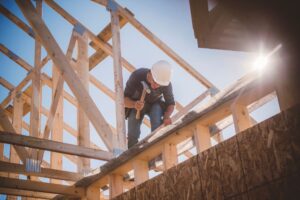Working alone on a construction site poses significant dangers, primarily due to the lack of immediate assistance in emergencies. Without nearby coworkers to provide aid or raise an alarm, injured workers face perilous situations with limited help options.
Additionally, the absence of colleagues decreases the likelihood of timely intervention for incidents like slips and falls, leading to prolonged suffering, worsened injuries, and future workers’ compensation cases. Isolation on the job can also exacerbate psychological stressors, reducing focus and increasing accident susceptibility.
Whether it’s a small project, maintenance work, or a unique situation where collaboration isn’t feasible, being alone on a construction job presents a host of challenges and risks that can have devastating effects.
Common construction site hazards
Common construction site hazards include:
- Entanglement in equipment: Operating heavy machinery, power tools, or equipment carries inherent risks, including entanglement and crush injuries. Without someone to offer assistance or intervene in case of an emergency, lone workers face extreme dangers.
- Falls from heights: Construction often involves tasks at elevated heights, such as roofing, scaffolding, or structural work. Without a colleague to provide assistance or alert to potential hazards, the risk of falls increases dramatically.
- Struck by objects: The bustling nature of construction sites means there’s a constant flurry of activity, including the movement of heavy machinery, swinging loads, and falling objects. For lone workers, the absence of a spotter or co-worker heightens the risk of being struck by such hazards.
- Electrical accidents: Construction sites are rife with exposed wiring and electrical equipment. Without a colleague to assist or provide immediate aid in case of an electrical accident, laborers are at increased risk of electrocution or electrical fires.
- Medical emergencies: In the event of a medical emergency, the absence of immediate assistance can exacerbate the situation. Whether it’s a minor injury or a life-threatening incident, employees may find themselves in precarious situations without prompt medical aid.
While the risks of working alone on a construction site may seem daunting, adhering to established best practices can help to substantially lessen the dangers involved. No matter the size or scope of the job, it’s imperative to prioritize safety at all times and follow essential guidelines for each task.
Best practices when working solo
Comprehensive training: All workers—especially those isolated on the job—should undergo thorough instruction on safety protocols, emergency procedures, and hazard recognition. This training should cover the proper use of personal protective equipment (PPE) and ensure that workers are equipped with the knowledge and skills to handle potential risks effectively. Most workers’ compensation lawsuits are a byproduct of little to no training in the first place.
Prioritize self care: Lone workers must prioritize their physical and mental well-being. Taking regular breaks and staying hydrated are essential for maintaining focus and alertness throughout the workday. Fatigue can impair judgment and increase the likelihood of accidents. Those working alone must listen to their bodies and take breaks as needed to rest and recharge.
Establish communication protocols: Regular communication with supervisors or designated safety personnel is also crucial. By maintaining open lines of communication, solo workers can ensure that someone is aware of their activities and can provide assistance or support if needed. Whether through check-ins, scheduled updates, or the use of technology like two-way radios or mobile devices, staying connected is essential for maintaining safety and addressing emergencies promptly.
Leverage technology: Using technology and tools that enhance safety and communication on the job is vital. Wearable devices with emergency alert capabilities, GPS tracking, or lone worker monitoring systems can provide an added layer of security and peace of mind. These technological solutions not only enable workers to signal for help in case of emergencies but also facilitate swift responses from supervisors or emergency responders.
Avoid high-risk actions: Those working alone should always exercise caution when engaging in high-risk activities, such as working at heights or operating heavy machinery, without assistance. Whenever possible, the help of colleagues or specialized personnel to mitigate risks should be sought.
Prepare for emergencies: Those working on a construction site should enroll in first aid training, obtain CPR certification, and have access to emergency response equipment such as fire extinguishers and first aid kits.
Remain vigilant: Lastly, isolated workers must stay alert to potential risks and dangers at all times. It’s vital to remain focused on the task at hand and avoid distractions such as using cell phones or listening to music, which can impair situational awareness.
Working alone on a construction site presents a variety of unique challenges that demand careful attention to detail and a proactive approach to safety. By following best practices such as thorough preparation, clear communication, knowing one’s limits, and remaining vigilant, isolated workers can significantly reduce the risk of accidents, injuries, and legal troubles regarding workers’ compensation. Prioritizing these measures not only safeguards one’s physical well-being, but also contributes to a more efficient and productive work environment.
Moreover, it’s essential to remember that every worker’s health and wellness is paramount, and taking practical steps to diminish on-the-job risks ensures they can return home safely at the end of each shift. Embracing a safety-first mindset not only protects the solo worker but also sets a positive example for colleagues and promotes a culture of safety throughout the construction industry.
Slawomir Platta, Esq., is founding partner, The Platta Law Firm, PLLC. Platta earned his degree from the University of Florida Levin College of Law. He’s been trying construction accident cases throughout the Courts of New York for 20 years and has been featured as a Super Lawyer consecutively since 2015.

